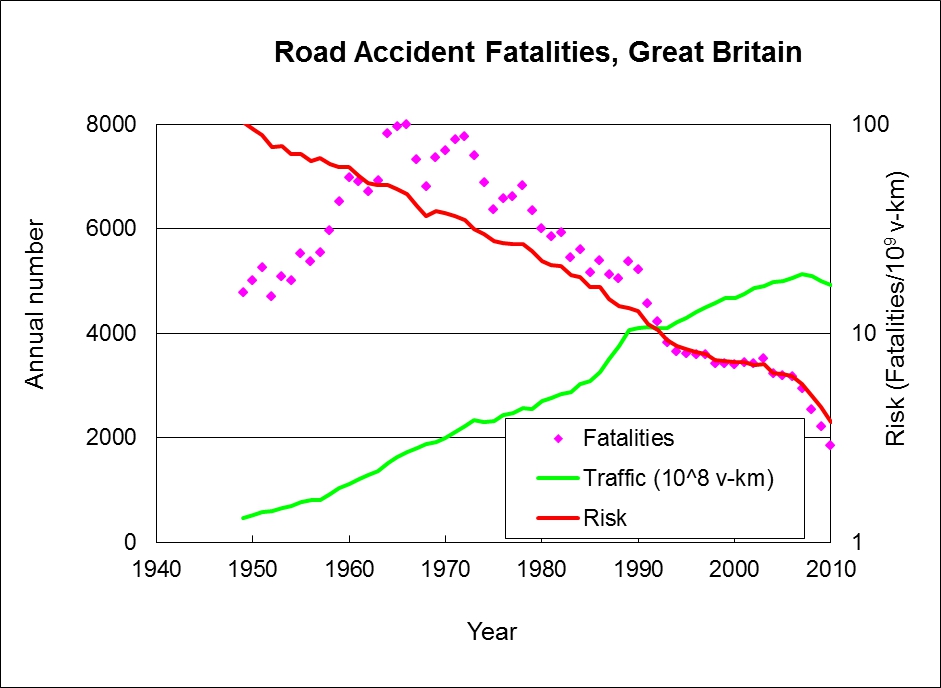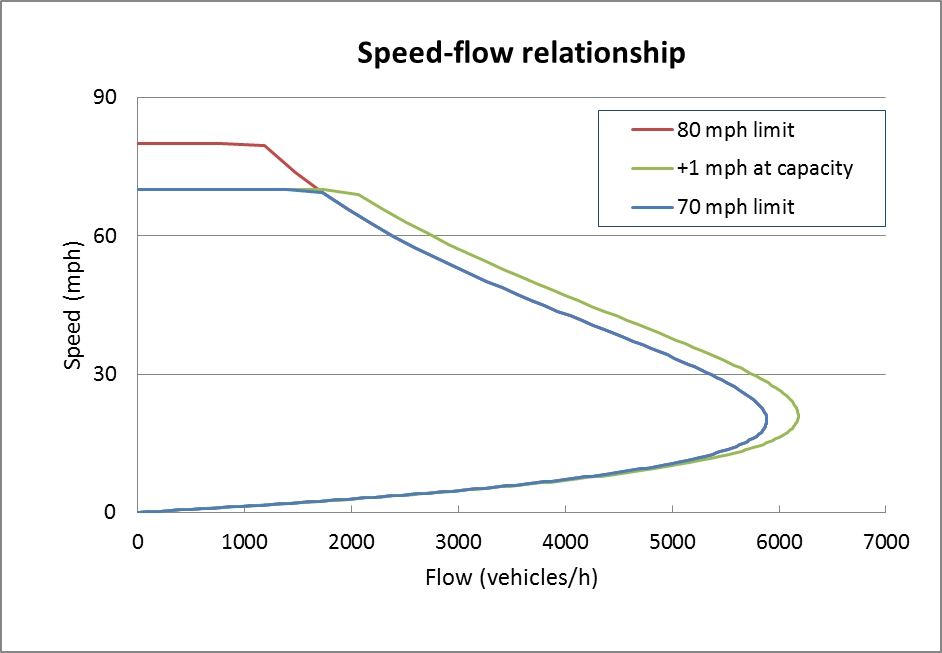 It was announced last month that the Department for Transport is to launch a consultation on increasing the speed limit for cars and light vans on motorways in England and Wales from 70mph to 80mph. Coupled with the recent M5 crash near Taunton, this has initiated a public debate over motorway speed and safety. Benjamin Heydecker finds that the government’s priorities should lie in raising capacity on motorways and ensuring that any intervention or innovation in how we use our roads should be at least safety-neutral.
It was announced last month that the Department for Transport is to launch a consultation on increasing the speed limit for cars and light vans on motorways in England and Wales from 70mph to 80mph. Coupled with the recent M5 crash near Taunton, this has initiated a public debate over motorway speed and safety. Benjamin Heydecker finds that the government’s priorities should lie in raising capacity on motorways and ensuring that any intervention or innovation in how we use our roads should be at least safety-neutral.
Last month saw the worst motorway crash in 20 years on the M5 near Taunton, when 34 vehicles were involved in an accident and subsequent fire that left 7 dead and 51 injured. The crash came only weeks after the Department for Transport announced a consultation on increasing motorway speed limits for cars and light vans to 80mph, up from 70mph. The then Transport Secretary, Phillip Hammond, cited large increases in safety and a general decline in road fatalities since the speed limit was set in 1965. But, now in light of the Taunton crash, what benefits and risks would an increased speed limit bring to motorway users?
We all want a transport system that is safe, convenient, reliable, affordable, accessible and efficient, attractive and comfortable: it is a long list of requirements. Road transport uses space that is shared by the public, so the actions of each user can have (often major) effects on others. There is much professional interest in maintaining the quality of road transport, including contributions from engineers, educators and enforcers. It is the government that determines priorities for investment in infrastructure, enforcement and regulation of usage, but in the end it is individuals whose usage determines the performance of the system. So the effect of changes in regulation can only be estimated when all effects through engineers, enforcers and educators on users’ activity have been explored.
Great fall in road fatalities since 1965
During the 45 years since the current motorway speed limit of 70mph was first implemented, the risk of road accident fatality per vehicle-km of travel has fallen to less than 1/13 of what it was. The annual number of road accident fatalities reported in Great Britain has decreased by a factor of more than 4, from 7,952 in 1965 (close to its all-time high) to 1,850 in 2010 (its lowest recorded value). During the same period, the annual distance travelled by motor vehicles on British roads has increased by a factor of a little over 3, from 160 billion vehicle-km in 1965 to 493 billion vehicle-km in 2010. So as a nation we are now travelling further in motor vehicles but are incurring fewer road accident fatalities. These trends are illustrated in Figure 1 with risk per vehicle-km shown on the right-hand, logarithmic scale.
Figure 1: Trends in road accident fatalities distance travelled and risk

Source: Data from Department for Transport (2011) Reported road casualties in Great Britain: annual report 2010. Presentation after Oppe, S and Koornstra, MJ (1990) A mathematical theory for related long term developments of road traffic and safety. In: Transportation and Traffic Theory (ed Masaki Koshi). Elsevier, 113-32.
The reduction in risk has benefitted all roads in the network, from urban minor roads to motorways. There is no single explanation for this astounding improvement in road safety, but rather there are many contributions through the efforts of government, professionals and practitioners. We now have safer roads used in safer ways by safer drivers in safer vehicles, and these developments are promoted by the professionals who work on engineering of roads and vehicles, who educate and who enforce governmental regulations.
Without increases in capacity, increasing the speed limit benefits few
The beneficial effects on travel times of increasing the speed limit on motorways from 70 mph to 80 mph are only likely to be noticeable in conditions where traffic is sparse and flow is low. This is because in other conditions speed is limited not by the legal limit but by some combination of the flow and the spacing between vehicles that drivers adopt. This is illustrated in the classic speed-flow diagram of Figure 2, in which the elevated speeds from an increase in the limit are available only at low flows occurring in free-flow conditions (the other possibility that gives rise to low flow is congested conditions that have low speeds).
Figure 2: Speed-flow relationships with increased speed limit and increased speed at capacity

There is no reason to suppose that changing the speed limit would affect capacity, and hence would have no benefits in alleviating congestion. This illustrates that the beneficiaries of an increase in the speed limit would be those travelling in light traffic, whereas the greater flows of travellers in busy conditions would not be affected at all. If, on the other hand, some method were found to increase capacity of motorways (and such measures are in prospect with the emergence of cooperative vehicle-highways systems) then this could benefit the many that are more strongly affected by congestion because they travel at busy times. The effect of a small (1 mph) increase in speed at capacity is also illustrated in Figure 2: this would benefit those travelling at high flows by increasing their own speed slightly and, more importantly, by increasing throughput and so reducing the congestion encountered by later travellers.
Raising the speed limit may lead to 15% more motorway deaths
So what are the safety consequences of an increase in motorway speed limits? The likely effects on casualties have been explored by the Transport Research Laboratory (TRL). They estimated that increasing the speed limit to 80mph would increase motorway fatalities by about 18 per annum, corresponding to 15% of the 118 fatalities that occurred on motorways during 2010. They also estimated smaller proportionate (but larger absolute) increases in serious and slight casualties. Their calculations were based on models that estimate that an increase in speed limit of 10 mph would increase average speeds by about 2.4 mph. A consequence of increasing the speed limit for the faster vehicles (cars and light vans) but leaving that for other slower vehicles (coaches and heavy goods vehicles) would be to increase the frequency of encounters between vehicles of these different kinds. This would increase the frequency of opportunities for crashes between the even faster cars and light vans on the one hand and the unaffected coaches and heavy goods vehicles on the other.
There is another, serious and topical concern. A vehicle travelling at 80 mph will have a greater stopping distance than one travelling at 70 mph: according to the highway code values for reaction time (2/3 s) and braking (about 2/3 g), they are 121 m and 96 m respectively (see Figure 3). A consequence of this is that a vehicle braking from 80 mph would still be travelling at 40 mph when it passes the stopping position of a vehicle that braked from 70 mph.
Figure 3: Speed during braking according to initial speed

It is a commonplace that most drivers believe themselves to be better than most other drivers – a cognitive bias of a kind known as illusory superiority. So increasing speed limits will appeal to those drivers who believe that they are better able than others to manage the greater speeds that will become legally acceptable. However, any such driver might then consider those drivers around themselves who, according to their own assessment, will be less able but can be expected to be similarly self-confident. It is these other drivers who could become involved in crashes downstream that precipitate blockages on the motorway. Worse still, more of these other less skilled drivers will be following behind.
How might a newly increased speed limit be enforced by the police? Although the police recognise that any driving in excess of the speed limit is an offence, they also follow a principle of proportionality in their enforcement of the law, and are widely believed not usually to enforce speeding offences that they measure to be within 2mph + 10% of the speed limit. The rationale for this is clear: the prospect of becoming embroiled in arguments over marginal infringements seem unattractive when more serious infringements are frequent. But the same rationale would apply if the speed limit were increased, so much stricter enforcement of an increased speed limit seems unlikely.
The issue of the acceptability of the proposed increase in motorway speed limits highlights a tension between individuals and society. Individuals will find this an attractive proposition if they are optimistic in their assessment of traffic conditions that will enable them to save minutes on their journeys and are also optimistic in their assessment of their own driving ability. They will seek personal gains of reduced travel times whilst discounting the consequences of increased risk of casualty to themselves and others. Against this is the consensus that safety is of particular importance, even if it is not to be considered to the exclusion of the other measures of performance.
A socially responsible stance might be that innovations and interventions should be considered only provided that they are at least safety-neutral. This would allow for justification of interventions on other grounds so long as they do not reduce safety. But this would also lead to the view that we should not give up any of the reduction in risk of casualty that has been gained over the decades of speed limited motorways.
Please read our comments policy before posting.





